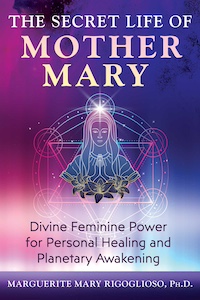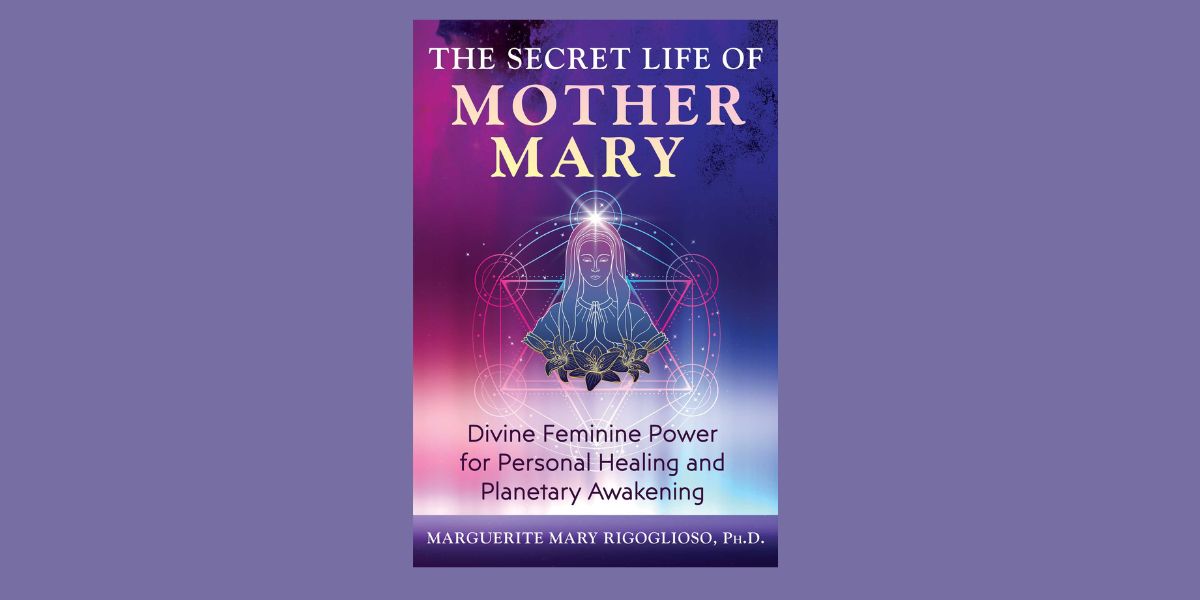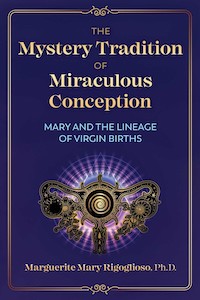
The Secret Life of Mother Mary: Divine Feminine Power for Personal Healing and Planetary Awakening, by Marguerite Mary Rigoglioso, Ph.D.
Bear & Company, 1591435242, 176 pages, July 2024
Mother Mary, whose divine conception led to the birth of Jesus Christ, is one of the most revered women to have ever lived. However, her real identity has been buried under years of patriarchal narratives that have hidden her true essence. In The Secret Life of Mother Mary: Divine Feminine Power for Personal Healing and Planetary Awakening, Marguerite Mary Rigoglioso, Ph.D. brings new insight about the role Mary played in not only Jesus’s birth, but also his resurrection, introducing to readers the truth of her divinity.
In this book, Rigoglioso teaches readers how Mother Mary was more than a docile, subservient woman chosen by God to birth the Lord and Savior Jesus Christ. She was actually highly skilled priestesses who had been trained since her own parthenogenetic conception in the spiritual arts. Not only did she achieve this feat, but at the end of her life, Mother Mary was able to fully ascend into divinity using a specific ritual “to help her complete her spiritual ascension and apotheosize–that is, fully merge with the Universal Divine Mother.”1
The humility of Mother Mary along with the level of her spiritual advancement make her a powerful spiritual healing force for us to call upon today in order to restore our connection to the Divine Mother, heal mother wounds, and usher in the wisdom of Mother Mary to our world through our own spiritual growth and revelation.
Drawing on the work of Sri Kaleshwar, in particular his book The Real Life and Teaching of Jesus Christ, which is based on Palm Leaf Manuscripts, Rigoglioso teaches readers about the Holy Womb Chakra. Rigoglioso identifies the womb chakra as physically “extending from the navel to the vulva and including all aspects of the uterus in between.”2 However, she also notes that men too have a womb chakra that can be activated.
“Kaleshwar teaches us that the energy he calls “Mother Divine” is the supreme Creator, though she does not create through what I call the “erector set” model of creation that has been handed down to us through the Hebrew Bible. Rather she has created her own womb chaka, or energy center.”3
Another interesting facet of the book is the exploration of the nature of relationships between Jesus and Mother Mary, Jesus and Mary Magdalene, and Mother Mary and Mary Magdalene. Rigoglioso also explores the role Mother Mary had in Jesus’s ministry, as demonstrated by the high reverence the apostles showed her, and Mother Mary’s relationship with Joseph and his family. All of this combines to paint a new picture of who these people were, showing their personal and spiritual lives that differs from the roles they’ve been cast in by Christianity.
The book is not merely a historical analysis; it is a spiritual journey that invites readers to connect with their own inner strength and healing potential. Rigoglioso shares plenty of her own experiences. And her writing is both scholarly and accessible, making complex ideas about spirituality and the divine feminine understandable to a broad audience. She blends thorough research with personal insights, creating a narrative that is both factually informative and deeply emotionally moving.
Readers are encouraged to embrace the divine feminine within themselves, which Rigoglioso asserts is essential for personal and planetary healing. At the end of each chapter, there are questions for reflection to help readers tap into their own perceptions, feelings, and beliefs about Mother Mary. Taking the time to journal one’s thoughts helps to initiate the process of opening to this information. Additionally, Rigoglioso provides free meditation on her website that can be used to further connect with Mother Mary.
Reading this book was a HUGE shift in perception for me. Admittedly, I was already a fan of Marguerite Mary Rigoglioso after reading her book The Mystery Tradition of Miraculous Conception. Prior to that book, I had taken a while to warm up to Mother Mary. She felt very virginal; her chastity and meekness was not something I was seeking in my teens and twenties. My spiritual growth came through working with Mary Magdalene, rewriting the historical narratives of who she was and the role she played in Jesus’s ministry and early Christianity.
However, once I understood the concept of parthenogenesis and the role that highly skilled priestesses had in the process through years of training, I saw a much fuller picture emerge. I was eager to see what new information Rigoglioso had to reveal in this book, which supplements her previous work beautifully. I might even suggest starting with this book if you’re new to Rigoglioso’s work as an introduction to the concept of parthenogenesis, or divine conception.
Rigoglioso challenges conventional religious narratives and encourages a more inclusive understanding of spirituality. Her work is a call to awaken to the interconnectedness of all beings and the importance of nurturing the feminine aspects of divinity. She urges us to remember the importance of these sacred lineages and that Mother Mary is always present for us, writing:
“Because what I have come to understand is that Mary is available. Due to her own tremendous spiritual achievements, she has become a resource on the inner planes that anyone (whatever your identity, religious affiliation, or level of spiritual interest) may draw upon to re-conceive, re-gestate, re-mother, and heal themselves.”4
Overall, The Secret Life of Mother Mary is a profound exploration into the life of one of history’s most enigmatic figures. Rigoglioso delves deeply into the hidden aspects of Mother Mary’s existence, painting a picture of a woman whose influence extends far beyond her traditional portrayal, which in turn offers new ways for people to understand and connect with her on a spiritual level. By examining ancient texts, spiritual teachings, and contemporary interpretations, Rigoglioso presents Mary as a goddess whose influence today is vital to healing the world, elevating her status beyond the confines of Christian narratives.
I absolutely loved this book, and I truly recommend it to everyone, as it offers a much-needed perspective about the sacred birth priestesses and their role in awakening planetary consciousness through their service of divine birth. Her book is a valuable resource for anyone interested in spirituality, personal growth, and the transformative power of the divine feminine. It serves as a compelling reminder that healing and awakening begin within, and that figures like Mother Mary can inspire us to reach our highest potential.
Alanna Kali is an astrologer, numerologist, and pioneer spirit that loves to explore life through the lens of depth psychology. She has a passion for studying the humanities and social trends. Her academic work is centered upon reuniting body, mind, and spirit through eco-psychology. She loves reading, spending time in nature, and travel.


